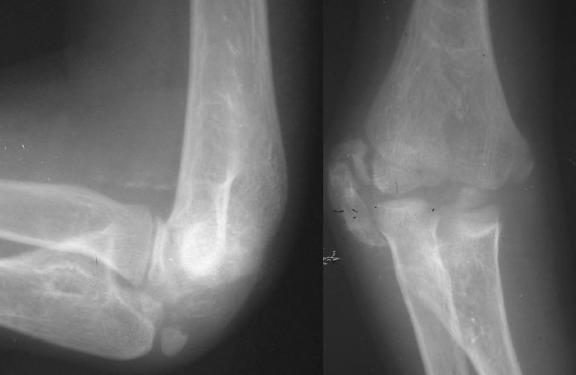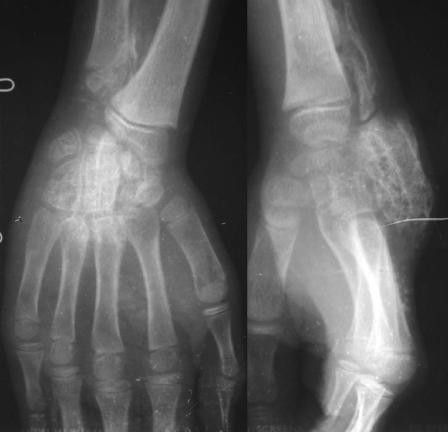Myositis ossificans usually affects young active adults.1 Occurring predominantly in muscles, a similar lesion may occasionally be found in subcutaneous tissues, tendons, fascia and periosteum. The occurrence of traumatic myositis ossificans in tissues of the hand is uncommon. We report a rare case of traumatic myositis ossificans occurring in extensor tendon sheaths of the hand and the wrist region in a 10-year-old boy.
Case report
A 10-year-old boy presented with a history of injury to the left upper limb 8 months earlier. He had fallen from a tree and sustained a closed injury to the left elbow and wrist. He received massage from a local osteopath for the initial 3–4 weeks, following which the elbow and wrist were mobilized. The pain and swelling gradually diminished over 8 months, but there was restriction of movement in the elbow and wrist joints.
On presentation, we noted some swelling in the elbow region and on the dorsum of the wrist. The local temperature was not increased and there was no erythema. A bony, hard mass was palpable over the lateral aspect of the elbow and the dorsum of the wrist, which was continuous with the parent bone. There was minimal local tenderness. Both the supracondylar ridges were indistinct and rounded. Active range of elbow movement was 60°–90°. Movement at the wrist ranged from 10° dorsiflexion to 20° palmar flexion. Both pronation and supination were restricted to 0°–40°. There was a mild Volkmann's ischemic contracture with a positive Volkmann's sign. Distal pulses were well palpable.
Anteroposterior and lateral radiographs of the elbow (Fig. 1) and wrist (Fig. 2) revealed ossification around the elbow and dorsal to the carpals and metacarpals in the location of the extensor tendon sheaths suggestive of traumatic myositis ossificans. There also was a suspicion of an epiphyseal injury to the lower end of the ulna.
FIG. 1. Anteroposterior (left) and lateral (right) radiographs of the elbow showing ossification in the soft tissues over the lateral aspect of the elbow joint.
FIG. 2. Anteroposterior (left) and lateral (right) radiographs showing soft-tissue ossification over the dorsum of the wrist suggestive of myositis ossificans in the extensor tendon sheaths. The distal end of the ulna shows evidence of a probable epiphyseal injury.
Considering the significant trauma that was subsequently treated by massage, a diagnosis of posttraumatic myositis ossificans was made. This was confirmed by subsequent histopathological examination.
Discussion
Most cases of osteitis ossificans reported in the literature are of a nontraumatic myositic mass arising in the soft tissues of the hand which mimic a neoplasm. Our patient had traumatic myositis ossificans in extensor tendon sheaths of the hand and wrist, a rare site for myositis.
Rothberg2 coined the term “tendonitis ossificans traumatica” a collective name given to calcification and ossification in or around tendons. This distinct entity is usually the result of a single traumatic injury and the heterotrophic new bone formation is considered to have no connection to bone, periosteum or muscle.
It is believed that mesodermal tissues respond by reactive proliferation to a traumatic stimulus.3 New bone formation is the result of increased vascularity and metabolism plus an excess of calcium brought to the injured part by the hyperemia of the injury. Radiographically, differentiation between calcification and ossification in a tendon is almost impossible. Exact differentiation is possible only by histopathological examination.
The differential diagnosis includes foreign-body granuloma, giant cell tumour of soft tissue (osteoclastoma), atypical fibroxanthoma and pseudosarcomatous fibromatosis (nodular fasciitis). Pseudomalignant myositis ossificans, a rare nontraumatic form of myositis ossificans, can sometimes involve the hand. It presents as a benign soft-tissue tumour exhibiting sarcoma-like features in the central area and is associated with mature bone in the periphery.4
Because of the self-limiting and benign nature of myositis, the treatment of this entity in most cases is conservative. However, intractable pain due to compression of neural tissue and limitation of function may require aggressive treatment with surgery.4
Competing interests: None declared.
Accepted for publication May 16, 2006
Correspondence to: Dr. Manish Chadha, C-A/16, Tagore Garden, New Delhi-110027, India; mchadha@hotmail.com
References
- 1.Mirra JM. Bone tumors: clinical, radiologic, and pathologic correlations. Philadelphia: Lea and Febiger; 1989. p. 1550-75.
- 2.Rothberg AS. Tendinitis ossificans traumatica. Am J Surg 1942;58:285-8.
- 3.Kwittken J, Branche M. Fasciitis ossificans. Am J Clin Pathol 1969;51:251-5. [DOI] [PubMed]
- 4.Kusuma S, Lourie GM, Lins RE. Myositis ossificans of hand. J Hand Surg [Br] 1999;24:128-30. [DOI] [PubMed]




